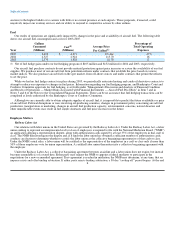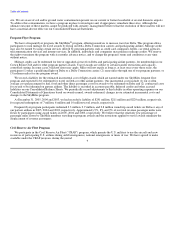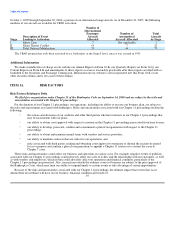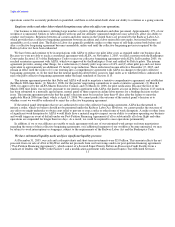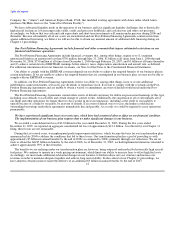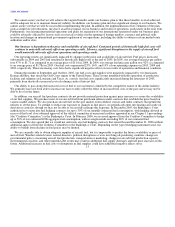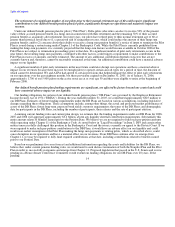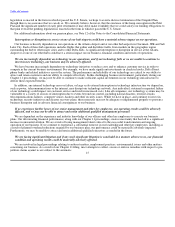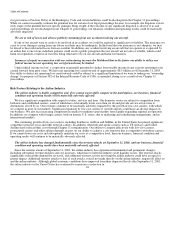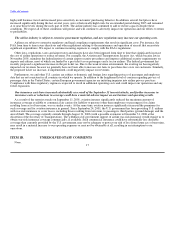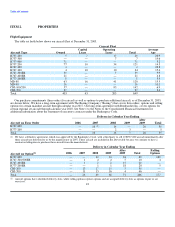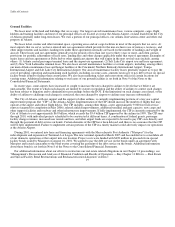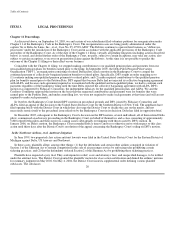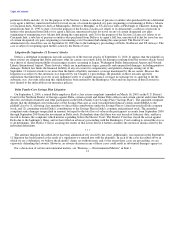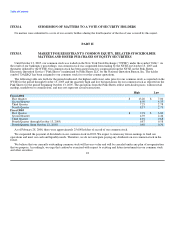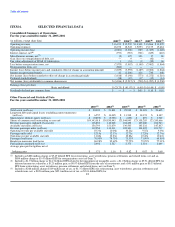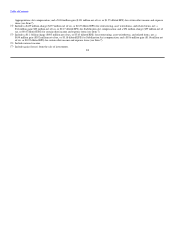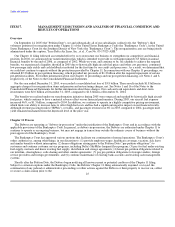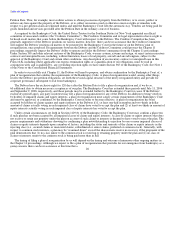Delta Airlines 2005 Annual Report Download - page 21
Download and view the complete annual report
Please find page 21 of the 2005 Delta Airlines annual report below. You can navigate through the pages in the report by either clicking on the pages listed below, or by using the keyword search tool below to find specific information within the annual report.
Table of Contents
stay provisions of Section 362(a) of the Bankruptcy Code and certain liabilities could be discharged in the Chapter 11 proceedings.
While we cannot reasonably estimate the potential loss for certain of our legal proceedings because, for example, the litigation is in its
early stages or the plaintiff does not specify damages being sought, if the outcome of any significant litigation is adverse to us and
such proceedings are not discharged in our Chapter 11 proceedings, our financial condition and operating results could be materially
adversely impacted.
We are at risk of losses and adverse publicity stemming from any accident involving our aircraft.
If one of our aircraft were to crash or be involved in an accident, we could be exposed to significant tort liability. The insurance we
carry to cover damages arising from any future accidents may be inadequate. In the event that our insurance is not adequate, we may
be forced to bear substantial losses from an accident. In addition, any accident involving an aircraft that we operate or is operated by
an airline that is one of our codeshare partners could create a public perception that our aircraft are not safe or reliable, which could
harm our reputation, result in air travelers being reluctant to fly on our aircraft and harm our business.
Issuances of equity in connection with our restructuring increase the likelihood that in the future our ability to utilize our
federal income tax net operating loss carryforwards may be limited.
Under federal income tax law, a corporation is generally permitted to deduct from taxable income in any year net operating losses
carried forward from prior years. We have net operating loss carryforwards of approximately $8.5 billion as of December 31, 2005.
Our ability to deduct net operating loss carryforwards could be subject to a significant limitation if we were to undergo an "ownership
change" for purposes of Section 382 of the Internal Revenue Code of 1986, as amended, during or as a result of our Chapter 11
proceedings.
Risk Factors Relating to the Airline Industry
The airline industry is highly competitive and, if we cannot successfully compete in the marketplace, our business, financial
condition and operating results will be materially adversely affected.
We face significant competition with respect to routes, services and fares. Our domestic routes are subject to competition from
both new and established carriers, some of which have substantially lower costs than we do and provide service at low fares to
destinations served by us. Our revenues continue to be materially adversely impacted by the growth of low-cost carriers, with which
we compete in most of our markets. Significant expansion by low-cost carriers to our hub airports could have an adverse impact on
our business. We also face increasing competition in smaller to medium-sized markets from rapidly expanding regional jet operators.
In addition, we compete with foreign carriers, both on interior U.S. routes, due to marketing and codesharing arrangements, and in
international markets.
The continuing growth of low-cost carriers, including Southwest, AirTran and JetBlue, in the United States has placed significant
competitive pressure on us and other network carriers. In addition, other hub-and-spoke carriers such as US Airways and United
Airlines have reduced their costs through Chapter 11 reorganization. Our ability to compete effectively with low-cost carriers,
restructured carriers and other airlines depends, in part, on our ability to achieve a cost structure that is competitive with those carriers.
If we cannot lower our costs and subsequently maintain our costs at a competitive level, then our business, financial condition and
operating results will continue to be materially adversely affected.
The airline industry has changed fundamentally since the terrorist attacks on September 11, 2001, and our business, financial
condition and operating results have been materially adversely affected.
Since the terrorist attacks of September 11, 2001, the airline industry has experienced fundamental and permanent changes,
including substantial revenue declines and cost increases, which have resulted in industry-wide liquidity issues. The terrorist attacks
significantly reduced the demand for air travel, and additional terrorist activity involving the airline industry could have an equal or
greater impact. Additional terrorist attacks or fear of such attacks, even if not made directly on the airline industry, negatively affect us
and the airline industry. Although global economic conditions have improved from their depressed levels after September 11, 2001,
the airline industry in the United States has continued to experience a reduction in
16


